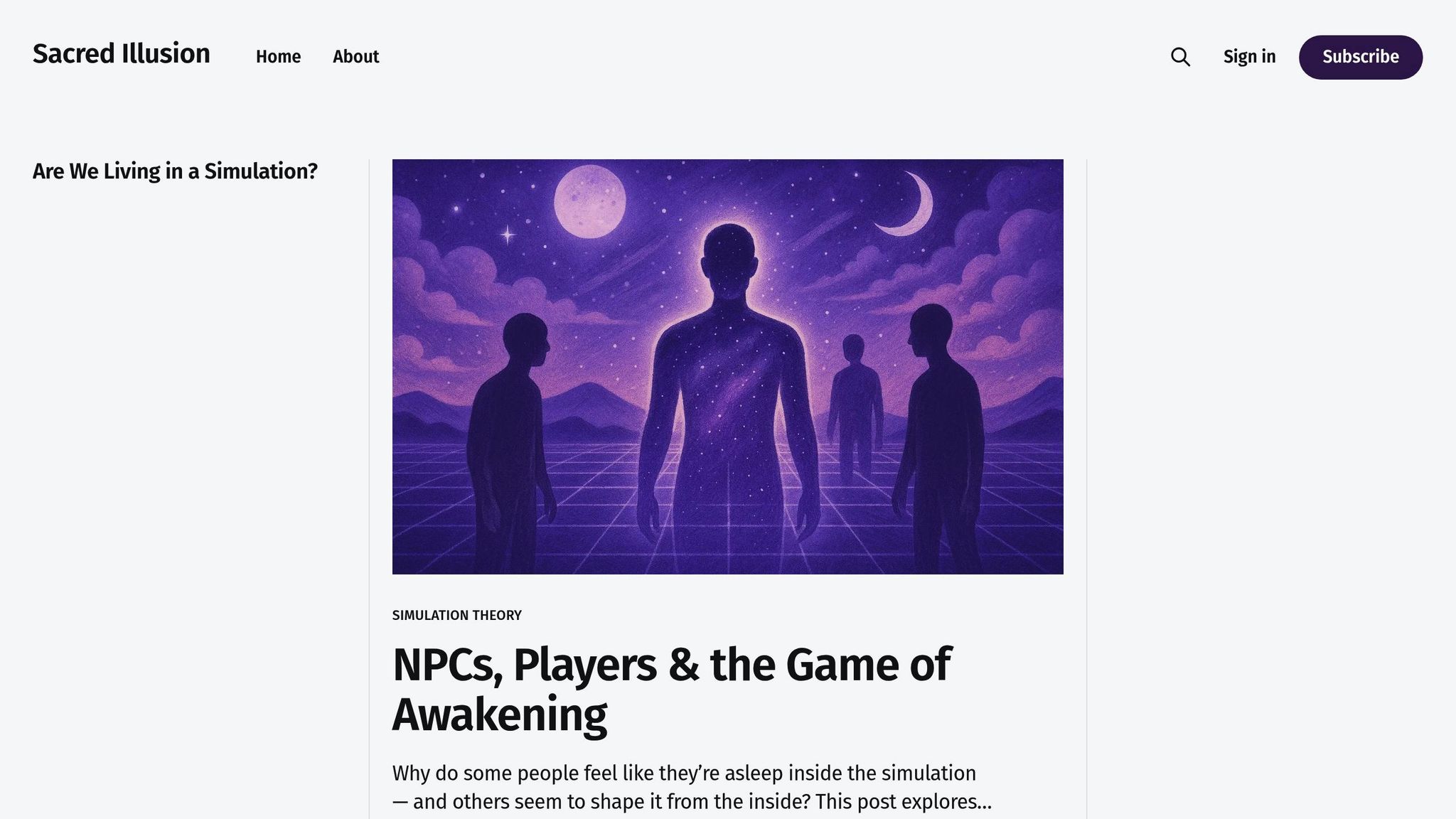Algorithmic Bias and Spiritual Perception
Explore how algorithmic biases shape spiritual exploration, limiting perspectives and creating echo chambers, while offering steps to regain control.

Algorithms are shaping how we explore spirituality - but are they helping or limiting us? Here's what you need to know:
- Algorithmic Bias: AI systems often favor certain perspectives due to biased data, narrowing the diversity of spiritual content you see online.
- Digital Tools in Spirituality: Platforms like social media and meditation apps prioritize engagement metrics, which can distort spiritual teachings by favoring popular over nuanced ideas.
- Patterns and Echo Chambers: Algorithms create patterns that may feel spiritual but are often based on user behavior, leading to echo chambers and reduced exposure to diverse views.
- Steps to Regain Control: Reset your digital habits - clear your search history, seek opposing perspectives, and balance online exploration with offline practices.
Quick Overview
| Challenge | Impact | Solution |
|---|---|---|
| Algorithmic bias | Limits diversity of spiritual content | Use platforms with transparency and diversity |
| Engagement-driven platforms | Promotes oversimplified teachings | Combine online tools with offline reflection |
| Echo chambers | Narrows spiritual perspectives | Deliberately seek diverse viewpoints |
How biased are our algorithms? | Safiya Umoja Noble | TEDxUIUC
How Algorithms Filter Spiritual Content
Algorithms play a subtle but powerful role in shaping how we explore spiritual content online. By analyzing our behaviors, these systems decide which spiritual topics appear in our feeds and search results, influencing the way we engage with such material.
When Algorithms Create Spiritual Patterns
Algorithms don’t just present information - they organize it in ways that can feel meaningful or even mystical. For instance, users often interpret algorithmically generated patterns as spiritual synchronicities. But these patterns are typically the result of metrics like engagement.
For example, if you interact with content about meditation, the algorithm is more likely to show you similar posts, making meditation appear more central to spiritual discourse than it might actually be.
Here’s how these patterns show up:
| Pattern Type | Algorithm Behavior | Impact on Perception |
|---|---|---|
| Content Clustering | Groups similar spiritual topics | Creates the illusion of trends in teachings |
| Engagement Amplification | Prioritizes highly-engaged content | Makes certain practices seem more significant |
| Temporal Correlation | Displays related content in sequence | Suggests spiritual “signs” or meaningful timing |
These patterns can subtly shape perceptions, often narrowing the scope of what users see and believe to be spiritually relevant.
Echo Chambers in Spiritual Content
Algorithmic filtering can also lead to echo chambers, where exposure to diverse spiritual perspectives becomes limited. Studies suggest that this filtering may erode traditional spiritual viewpoints by promoting a narrower range of content.
Here are some ways this happens:
- Content Reinforcement: Algorithms repeatedly present material that aligns with a user’s existing beliefs, further narrowing their worldview.
- Engagement Bias: Content that sparks high interaction is prioritized, often favoring simplified or overly popularized spiritual ideas.
- Cultural Filtering: Certain spiritual traditions are sidelined by algorithmic biases, while others receive disproportionate attention.
Interestingly, research has shown that thoughts of God can influence how people perceive human and algorithmic judgment. When people think about God, they often feel smaller and more aware of human imperfection.
This psychological effect is significant, with studies showing that God-related thoughts evoke stronger feelings of smallness (B = 0.98; t = 6.26, P < 0.001) and heightened beliefs in human imperfection (B = 0.18; t = 2.27, P = 0.024). These shifts in perspective might make individuals more inclined to trust algorithmic recommendations over human opinions.
Steps to Reduce Algorithm Influence
Digital platforms play a significant role in shaping our spiritual journeys. To regain control over your spiritual exploration and reduce the sway of algorithms, consider these actionable steps. High levels of AI influence have been linked to a decline in reliance on traditional spiritual beliefs.
Methods to Increase Awareness of Digital Content
Resetting algorithmic patterns and minimizing their grip requires intentional strategies. Here are some practical methods:
| Method | How to Apply It | What It Achieves |
|---|---|---|
| Profile Reset | Clear your search history and cookies every month | Disrupts algorithmic predictions and patterns |
| Platform Rotation | Use 3–4 different platforms on a weekly basis | Reduces dominance of a single algorithm |
| Contrary Searching | Deliberately seek out opposing perspectives | Breaks through echo chambers |
| Content Audit | Regularly review the spiritual content you consume | Helps identify recurring patterns |
In addition to these digital techniques, make time for offline reflection. Practicing mindfulness and contemplation away from screens can help you reconnect with your inner guidance.
Practical Truth-Testing Methods by Sacred Illusion

Beyond general awareness, Sacred Illusion offers specific techniques to help you filter out algorithm-driven noise and connect with authentic spiritual insights:
-
Embodiment Testing
Pay attention to how your body and emotions respond to spiritual content online. Genuine insights often evoke a sense of peace or clarity. -
Synchronicity Observation
Notice meaningful coincidences that occur naturally, rather than those suggested by algorithms. This builds your ability to discern organic spiritual connections. -
Integration Assessment
Test whether digital spiritual insights resonate over time. Authentic ideas tend to have lasting value, while algorithm-driven content often fades quickly.
Developing an understanding of how algorithms curate your digital experience is key. Balance this with offline practices by creating "algorithm-free zones" - spaces or times where you disconnect from devices and engage in unmediated spiritual exploration.
Studies show that spiritual seekers who combine regular offline practices with mindful digital use report clearer discernment and deeper, more personal spiritual experiences. By adopting these methods, you can challenge digital biases and rediscover a more personal, unfiltered spiritual truth.
Building Better Digital Spiritual Spaces
Designing Unbiased Spiritual Platforms
Creating fair and inclusive digital spaces for spiritual exploration requires a thoughtful approach to design. Studies highlight how AI-generated religious content can subtly influence attitudes.
For instance, exposure to such content has been linked to a slight increase in positive ratings for Christianity (up by 0.31 points) and a decrease for Islam (down by 0.23 points).
To counter these challenges, platforms can incorporate specific design features aimed at promoting balance and fairness:
| Design Feature | Purpose | Impact |
|---|---|---|
| Diversity Metrics | Track representation across traditions | Encourages balanced exposure |
| User Controls | Enable custom filtering options | Reduces potential blind spots |
| Transparency Tools | Clarify content recommendation logic | Fosters informed engagement |
| Serendipity Algorithms | Introduce diverse viewpoints | Breaks echo chambers |
| Regular Audits | Consult diverse spiritual experts | Ensures content integrity |
Additionally, tools like bias detection systems and diversity dashboards empower users to actively monitor and adjust the variety of spiritual perspectives they encounter. These strategies are integral to fostering unbiased environments and reflect the guiding principles of Sacred Illusion.
Sacred Illusion's Content Standards
Sacred Illusion has embraced these design principles by developing robust content standards aimed at countering algorithmic biases. The platform prioritizes depth and meaningful engagement over superficial metrics like virality.
Here’s how Sacred Illusion ensures fair and balanced spiritual content:
-
Multiple Perspectives Policy
The platform curates content that represents a wide range of spiritual traditions and philosophies. Topics like reality as illusion, simulation theory, and conscious manifestation are explored through a lens that values inclusivity and diversity. -
Bias-Conscious Curation
Sacred Illusion focuses on educational value rather than engagement metrics. This approach helps minimize the risk of users unconsciously absorbing biased information. -
Transparency Framework
By offering clear insights into content sourcing and background, Sacred Illusion empowers users to critically engage with complex spiritual ideas. Research shows that understanding how content is selected enables users to navigate biases more effectively.
These standards reflect Sacred Illusion’s commitment to creating a space where users can explore spiritual ideas with clarity and balance.
Conclusion: Finding Truth in the Digital Age
In today’s world, algorithms don’t just deliver content - they shape how we perceive it. When it comes to spiritual exploration, this influence can create echo chambers, narrow perspectives, and even alter the way we engage with deeper questions. That’s why stepping back and finding balance between digital tools and offline practices is so crucial.
Key Takeaways
Navigating the intersection of technology and spirituality requires a thoughtful approach. Research shows that concepts like "God salience" can increase trust in algorithmic systems by up to 8.17%. This highlights the importance of maintaining critical thinking while engaging with spiritual content online.
| Aspect | Challenge | Solution |
|---|---|---|
| Digital Awareness | Echo chambers from algorithms | Explore diverse spiritual perspectives regularly |
| Personal Agency | Overreliance on AI | Balance online exploration with offline practices |
| Content Evaluation | Biased filtering of information | Choose platforms with transparent content policies |
| Spiritual Growth | Reduced self-reflection | Practice regular, critical self-inquiry |
These challenges remind us that technology, while helpful, can never replace the depth of personal reflection or the richness of human connection.
To stay grounded, consider these practices:
- Question digital sources: Don’t take everything at face value; seek a variety of viewpoints.
- Balance your approach: Pair online exploration with offline rituals or practices that encourage self-reflection.
- Use trustworthy platforms: Opt for services that prioritize transparency and encourage diverse perspectives.
Platforms like Sacred Illusion aim to support this balance, offering curated content that encourages users to look inward and find their own truth. Ultimately, the path to spiritual growth in the digital age isn’t just about what you consume - it’s about how you engage with it.
Ready to step beyond information and into activation?
This blog is part of an ongoing personal study — a living exploration of simulation theory, manifestation, and reality-bending. If something here resonated, you’re not here by accident.
Join the journey.
Get deeper insights, tools, and transmissions delivered to your inbox: no noise, no fluff — just real signals for seekers.
FAQs
How can I recognize and overcome algorithmic bias when searching for spiritual content online?
Algorithmic bias has a way of shaping the spiritual content you come across online, often without you even noticing. That’s why it’s crucial to stay mindful of how this bias might influence your experience.
If the content you’re seeing starts to feel repetitive or seems to heavily lean toward a single perspective, it could be a sign that algorithms are steering you toward certain viewpoints - likely based on your past clicks, likes, or trending topics.
To push back against this, make a conscious effort to explore a variety of voices, especially those from underrepresented or marginalized communities. Step outside your usual platforms and dig into content that challenges your usual feed.
Ask yourself how algorithms might be filtering or shaping what you see. By doing this, you can open the door to a more well-rounded and inclusive take on spiritual ideas.
How can I create a balanced spiritual journey that combines online tools with offline practices?
To nurture a balanced spiritual journey, try combining online resources with offline practices in a thoughtful way. Online platforms can offer a treasure trove of meaningful content - think essays, guides, or rituals - that can deepen your understanding and provide support for your inner growth.
Meanwhile, offline activities like meditation, journaling, or spending time in nature can help ground these experiences in the physical world.
The key is to let online tools serve as inspiration rather than a substitute for personal exploration. This balance allows you to stay connected to your unique spiritual path while still drawing on the wisdom and insights available in the digital space.
What are echo chambers in digital spiritual spaces, and how can I avoid them?
Echo chambers in digital spiritual spaces happen when algorithms and personal preferences keep showing you content that matches your current beliefs. This creates a cycle where you're repeatedly exposed to the same ideas, limiting your perspective and reinforcing a narrow view of the world.
To break out of these echo chambers, make an effort to explore different viewpoints. Join communities with diverse beliefs, have meaningful conversations with people who think differently, and allow yourself to question and engage with challenging ideas.
Offline interactions and reading from a range of sources can also help expand your understanding. Pay attention to the content you consume, consider where it comes from, and stay open to fresh perspectives. Taking these steps can bring more balance to your spiritual journey and encourage deeper personal growth.




